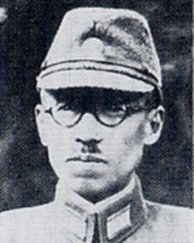Shimomura Sadamu
Shimomura Sadamu ( Japanese 下 村 定 ; * September 23, 1887 in the prefecture of Kōchi , Japanese Empire ; † March 25, 1968 ) was a general of the Imperial Japanese Army , the last Minister of the Japanese Empire and a member of the Upper House of the Japanese Parliament at the time after the Pacific War .
Life
Shimomura Sadamu was born in Kōchi Prefecture in September 1887. In 1908 he graduated from the Army Officer School with, among others, the princes Asaka Yasuhiko , Higashikuni Naruhiko and Kitashirakawa Naruhisa . Eight years later he graduated from the Army University . After a number of administrative and staff posts on the Army General Staff , Shimomura was sent to France as a military attaché in 1919 . After his return he served in the Office for Strategic Planning of the Army General Staff in 1921. In 1928, 1929 and 1931 he was part of the Japanese delegations to the Geneva Naval Conference . From 1933 to 1935 he was in command of the Army's 1st Heavy Field Artillery Regiment.
In 1935 Shimomura received a staff position in the Kwantung Army stationed in the Japanese puppet state of Manchukuo , and the following year he was promoted to major general . From 1936 to 1938 he served again in the Army General Staff, where he advocated a more aggressive stance against the Republic of China (1912-1949) in the Shanghai area , where there were repeated tensions between Chinese and Japanese troops who were supposed to protect the Japanese concessions in the city , came. In 1937, his opinion influenced the management of the Army General Staff to the effect that they landed the 10th Army in China in support of the fighting that broke out in Shanghai . These battles immediately sparked the Second Sino-Japanese War .
In 1939 Shimomura's promotion to lieutenant general took place . In 1940 he became commander of the Army Artillery School and on October 8, 1942 he was given field command of the 13th Army . This was stationed in the area around Shanghai and the adjacent provinces to fend off a possible amphibious landing by Allied troops in the mouth of the Yangtze River . In March 1944 he was recalled to the main Japanese islands and received on the 22nd of the month the supreme command of the Western District Army , which was responsible for the southern area of Honshū , Shikoku and the Ryūkyū Islands . In November 1944 he was sent back to China and assumed command of the Northern China Regional Army . He formally retained this post until the army was disbanded after the capitulation of Japan .
In 1945 Shimomura was promoted to full general and on August 23, after the announcement that Japan would accept the Potsdam Declaration , he became Minister of Defense in the cabinet of Prime Minister Higashikuni Naruhiko, who had previously held the post for a short time. He was selected for the post because he was never involved in direct combat operations with American or Commonwealth forces. His main task was to coordinate and monitor the demobilization of all remaining troops of the army and to plan the return transport of the troops to Japan together with the victorious allies. After Shidehara Kijūrō had taken over the post of Prime Minister on October 9, 1945 , Shimomura remained Minister of the Army. His term of office ended on December 1, 1945, when the Army Ministry was transformed into the First Ministry of Demobilization . In parallel to his work as Minister of the Army, he was the last General Inspector of Military Training until October 1945 .
In 1946 and 1947, Shimomura, like all former members of the government, was briefly interned by the Allies, but was released without charge for possible crimes committed during the war.
On June 2, 1959 , he was elected for the Liberal Democratic Party through the nationwide constituency for a term in the upper house of the Japanese parliament. On March 25, 1968, Shimomura Sadamu died in a traffic accident at the age of 80.
literature
- Ben Ami Shillony: Politics and Culture in Wartime Japan. Oxford University Press, Oxford 1981, ISBN 0-19-820260-1 .
- Masahiro Yamamoto: Nanking. Anatomy of an Atrocity. Greenwood Publishing Company, London 2000, ISBN 0-275-96904-5 .
Remarks
- ↑ Masahiro Yamamoto: Nanking. Anatomy of an Atrocity. 2000, p. 42.
- ↑ Ben Ami Shillony: Politics and Culture in Wartime Japan. 1981, p. 89.
- ↑ Sangiin: Historical Members of Parliament , Sat – Sun ( Memento of the original from June 26, 2012 in the Internet Archive ) Info: The archive link was automatically inserted and not yet checked. Please check the original and archive link according to the instructions and then remove this notice. (PDF; 167 kB)
| personal data | |
|---|---|
| SURNAME | Shimomura, Sadamu |
| ALTERNATIVE NAMES | 下 村 定 (Japanese) |
| BRIEF DESCRIPTION | Japanese general and politician |
| DATE OF BIRTH | September 23, 1887 |
| PLACE OF BIRTH | Kochi Prefecture , Japanese Empire |
| DATE OF DEATH | March 25, 1968 |
| Place of death | Japan |
